President Joe Biden took office in January 2021 with a plan for appointing judges very different not only from his predecessor, President Donald Trump, but from what America’s Founders prescribed for the system of government they established. For this reason, it is important to assess Biden’s progress in appointing judges and, by doing so, in pushing the judiciary in his preferred direction.
Many of Biden’s supporters had already described the judicial selection approach they expected his Administration to take. More than 70 liberal organizations, for example, issued a statement shortly after the 2020 election that Biden’s nominees should have “a demonstrated commitment to equal justice,” be “demographically diverse,” and “come from a range of professional backgrounds.”REF While some advocates suggest that “personal” and “professional diversity” will simply add “perspectives to the Federal bench,”REF this approach is actually motivated by the belief that a judge’s personal views and past experiences not only can, but should, drive his or her decisions.REF
Liberals generally see the judiciary’s role as producing desirable outcomes and, therefore, look for nominees with the personal or demovic characteristics, life experience, or professional background that they believe will contribute to this goal. The 2020 statement mentioned above, for example, plainly stated this objective. “All the [Biden] administration’s priorities, from preserving the Affordable Care Act, voting rights, women and reproductive rights, communities of color, LGBTQ communities, workers, the environment, consumers, and key civil rights hang in the balance in the courts.”REF
One month later, the incoming Biden Administration made clear that its judicial nomination process would follow these instructions. Dana Remus, Biden’s choice for White House Counsel, wrote U.S. Senators that the Administration wanted to appoint judges with a “wide range of life and professional experiences, including those based on their race, ethnicity, national origin, gender, sexual orientation, gender identity, religion, veteran status, and disability.” The Biden Administration was “particularly focused on nominating individuals whose legal experiences have been historically underrepresented on the federal bench, including those who are public defenders, civil rights and legal aid attorneys, and those who represent Americans in every walk of life.”REF Specific life experiences and professional backgrounds are not an end in themselves, but a means to the end of more favorable judicial decisions on key issues.
The observation that personal characteristics or professional background can potentially influence a judge’s decision is not, by itself, unusual. Traditionally, however, that has been seen as a factor to be deliberately minimized rather than fostered. This is because the most foundational principle of the judicial system is the impartial application of the law. The oath that federal judges take, for example, requires them to “administer justice without respect to persons, and do equal right to the poor and to the rich.”REF Chiseled in stone above the Supreme Court’s entrance are the famous words “Equal Justice Under Law.”
The previous Democratic President, Barack Obama, also had a subjective approach to judicial appointments that undermined the principle of impartiality. As a Senator opposing the 2005 nomination of Chief Justice John Roberts, for example, Obama argued that judges should decide cases based on their “deepest values…core concerns…broader perspectives on how the world works, and the depth and breadth of [their] empathy.”REF Four years later, as President, Obama appointed Sonia Sotomayor to the Supreme Court, who had given speeches questioning even the possibility of impartiality: “I would hope,” she said, “that a wise Latina woman with the richness of her experiences would more often than not reach a better conclusion than a white male who hasn’t lived that life.”REF
The Biden Administration appears to have gone even further down this road. Biden first promised that he would appoint a black woman to the Supreme Court during the presidential campaign. At the Democratic candidates’ debate on February 25, 2020, Biden said he would do so “to make sure that we, in fact, get everyone represented.” He has never explained who is included in “everyone” or what he meant by “represented,” a term better understood in relation to the legislative or executive branches.
Similarly, Senate Majority Leader Charles Schumer (D–NY) recently said that courts should “look more like the country they serve.”REF Schumer has not explained how any group of nine men and women can “look like” a diverse country of 330 million people. He has, however, argued that when Americans go to court, “they should trust that those who render judgment will be able to understand each litigant’s lived experience and bring a modicum of human understanding required to apply the law equitably.”REF That still begs important questions, such as how litigants can possibly know what particular judges may understand about their “lived experience,” whether that understanding is even correct, whether or how it should factor into judicial decision-making, or what it means for judges to apply the law “equitably.”
This Legal Memorandum will evaluate Biden’s success in appointing judges to life-tenured federal courtsREF during his first year in office. Data regarding his appointments will be presented in the context of both long-term confirmation process norms and previous presidents’ first-year judicial appointments.
The Founders’ Prescriptions
The Constitution provides for both the exercise of judicial power and the appointment of those who would exercise it. At her 1993 confirmation hearing, the late Justice Ruth Bader Ginsburg explained that “[j]udges in our system are bound to decide concrete cases, not abstract issues,” by applying the governing law to the facts of each case.REF More recently, Justice Clarence Thomas similarly described the “judicial task” as “interpret[ing] and apply[ing] written law to the facts of particular cases.”REF By taking their oath of office, judges pledge to perform these duties “impartially.”REF
The ongoing debate over the power and proper role of judges in our system of government focuses primarily on interpretation of written law.REF In a system of government based on the “consent of the governed,”REF the Constitution “contains the permanent will of the people…and can be revoked or altered only by the authority that made it.”REF The Constitution is written so that its assignment of powers to the different branches, and its limits on those powers, “may not be mistaken, or forgotten.”REF
Since written law can be “altered” by changing either its text or the meaning of that text, impartial interpretation must seek the meaning of written law intended by the “authority that made it.” Otherwise, Justice George Sutherland warned in 1937, the judiciary could amend the Constitution “in the guise of interpretation.”REF The Founders thus sought to “avoid an arbitrary discretion in the courts” by binding judges with “strict rules and precedents” that would “define and point out their duty in every particular case that comes before them.”REF
The Founders also established a process for appointing those who would exercise judicial power. The Constitution gives to the President the power to nominate federal judges and requires the “Advice and Consent of the Senate”REF for the President to appoint his nominees. The President thus exercises the primary appointment power, while the Senate’s secondary role can be “an excellent check” to prevent “the appointment of unfit characters.”REF Rejecting a nominee, the Founders believed, would require “special and strong reasons” rather than simply “the preference [the Senate] might feel to another.”REF
Confirmation Process Norms
These prescriptions led naturally to several long-standing norms for the Senate’s confirmation process.REF For most of American history, the Senate respected the President’s appointment power and, absent “special and strong reasons” for opposition, confirmed nearly all judicial nominees with little or no opposition, without a recorded vote, and with neither systematic partisanship nor procedural obstacles such as separate votes to end debate as a condition of final approval. Confirmation conflicts, which focused on individual nominees, were the rare exception rather than the rule. The following charts show the long-term historical pattern for each of these norms and how they have changed during the most recent presidential administrations.
Increasing Overall Opposition. From 1789 to 2000, the Senate confirmed 97 percent of nominees to life-tenured federal court with no opposition. This pattern remained true even when there was a significant conflict over an individual Supreme Court nominee during a particular administration. While the Reagan Administration, for example, is remembered for the defeat in 1987 of Supreme Court nominee Robert Bork, only six of Reagan’s 383 judicial appointments had any confirmation opposition. Similarly, while the conflict over Justice Clarence Thomas’ 1991 Supreme Court nomination will always be associated with the George H. W. Bush Administration, only 1.5 percent of Bush’s judicial nominees were confirmed with any opposition at all. The first significant drop in the percentage of judicial nominees confirmed without opposition occurred during the Barack Obama Administration; the trend increased under President Donald Trump and has dropped to zero since Biden took office.
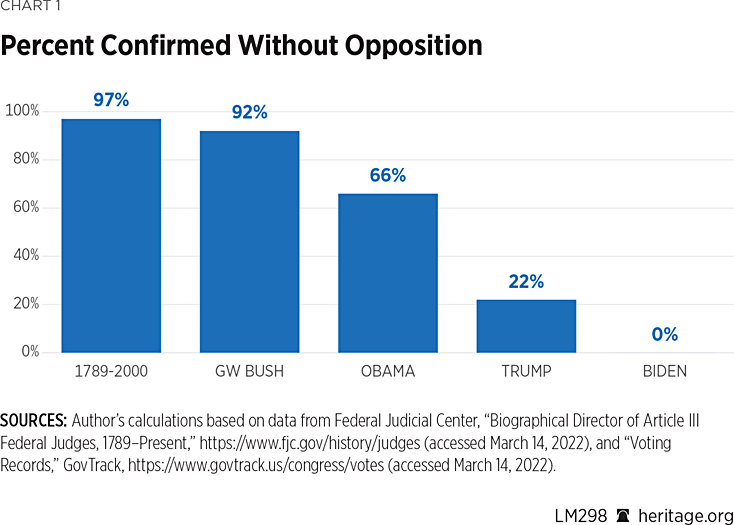
Use of Recorded Votes. The Senate can confirm nominees informally and quickly, or formally and slowly. Traditionally, nominees with no opposition were confirmed by either unanimous consent or voice vote, which does not require the presence of Senators and takes only a minute or two. For the rare nominees with opposition, the Senate used a recorded vote, which requires the presence of all Senators and takes an average of 35 minutes or more.REF Unanimous recorded votes, therefore, were rare; less than 1 percent of the judicial nominees confirmed without opposition between 1789 and 2000 had a recorded vote.
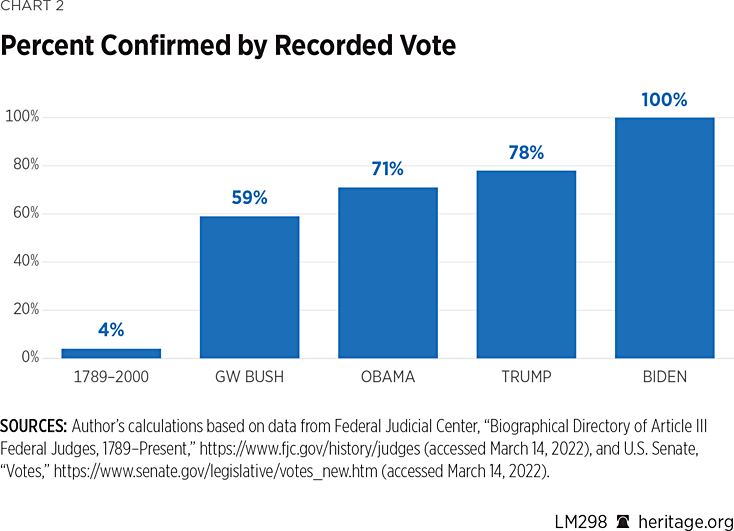
This norm changed significantly during the George W. Bush Administration. While the percentage of judicial nominees confirmed without opposition remained high, the percentage confirmed by recorded vote rose 15-fold from the historical average. For the first time during any administration, a majority of Bush nominees confirmed without opposition had a recorded vote.
Systematic Partisan Opposition. The historical pattern of confirming most judicial nominees without opposition or recorded votes did not vary with partisan control of either the Senate or the White House. Senators of one party opposed very few judicial nominees by Presidents of the other party. The largest shift in this norm occurred during President Donald Trump’s term, the first in which other-party Senators opposed, on average, a majority of a President’s judicial nominees. Before 2017, no Senator of either party opposed more than 14 percent of judicial nominees by a President of the other party; under President Trump, no Democrat opposed less than 19 percent of his nominees.
A Senator directly expresses opposition to a nominee by a recorded negative vote on confirmation. Chart 3 presents the average number of judicial nominees by each President opposed by Senators of the other party who served during at least three-quarters of that President’s tenure.REF
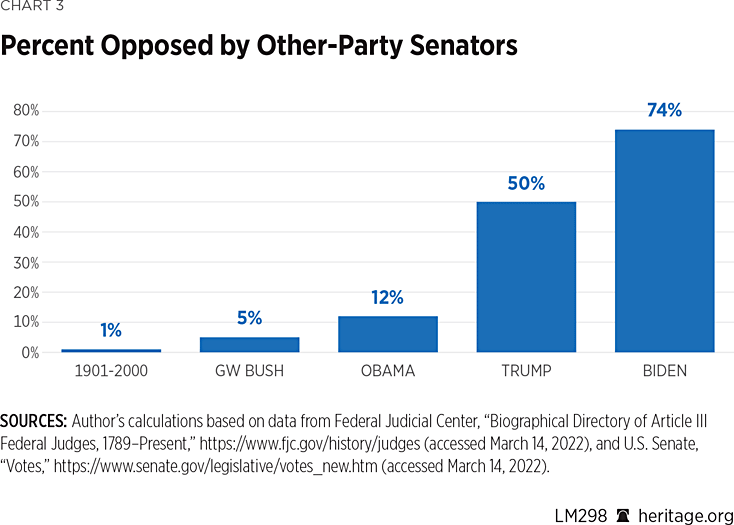
Cloture Votes. Another confirmation process norm was that the Senate proceeded to final confirmation without any procedural obstacles such as a separate vote to invoke cloture, or end debate. The Senate’s legislative process has included requiring a supermajority to end debateREF since the turn of the 19th century and was formalized in Senate Rule 22 in 1917.REF While the Senate’s 1949 extension of the rule to any pending “matter,” intended to include motions as well as bills,REF could arguably cover nominations, the Senate did not take a cloture vote on a nomination for another two decades. In fact, the Senate took a cloture vote on less than 1 percent of the judicial nominees confirmed to Article III courts between 1949 and 2000, and only one nominee was not confirmed.REF
This norm changed during George W. Bush’s first term. Democrats forced the Senate to take 23 cloture votes on 13 different appeals court nominees; 20 cloture votes failed, resulting in filibusters. These were the first filibusters in American history to block confirmation of majority-supported judicial nominees.REF Even though filibusters declined significantly when Democrats controlled the Senate during the Obama Administration,REF Democrats succeeded in eliminating the filibuster for nominations to every executive and judicial position but the Supreme Court in November 2013. They used a prearranged parliamentary ruling, endorsed by a party-line Senate vote, to reinterpret the “three-fifths” required by Rule 22 to mean only a simple majority.REF As a result, the same majority that can confirm a nominee can also invoke cloture, effectively abolishing nomination filibusters.
As this history demonstrates, this confirmation process norm changed in two ways. First, between 2003 and 2013, when Rule 22’s supermajority requirement meant what it said, filibusters were used to prevent final confirmation votes of judicial nominees. Second, since 2013, with Rule 22’s supermajority requirement “amend[ed] in the guise of interpretation,”REF cloture votes have become a routine step in the confirmation process even though they can no longer prevent confirmation. In 2014, for example, Republicans forced the Senate to take a cloture vote on 78 of the 89 nominees confirmed to Article III courts, even though each nominee who had a cloture vote was then confirmed, a majority of them without any final opposition.
During the Trump Administration, the percentage of judicial nominees who were subjected to a cloture vote before confirmation vote nearly tripled, and it has been the uniform practice since Biden took office.
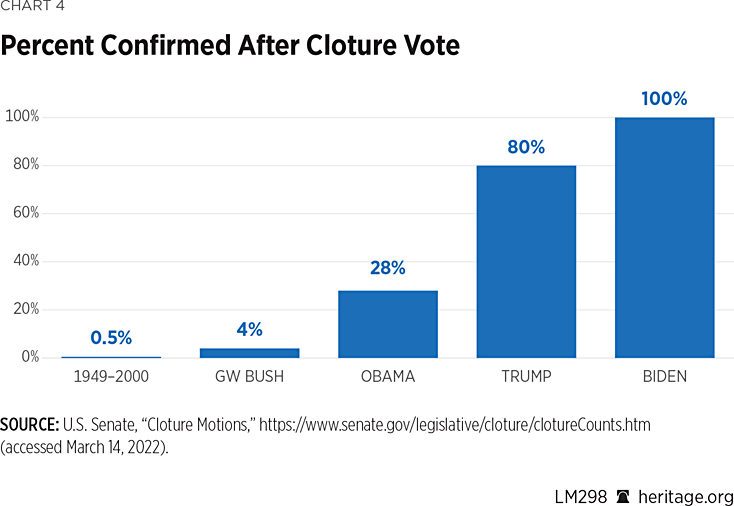
President Biden’s First-Year Judicial Appointments
Judicial Vacancies. President Biden took office and began appointing judges against this backdrop of changing confirmation process norms. The nomination and confirmation pace during the Trump Administration had reduced vacancies in January 2021 to 5.4 percent, compared to an average of 8.7 percent when Biden’s six predecessors took office. Biden made his first judicial nominations on March 17, 2020, earlier than the five previous new Presidents of a different party than their predecessor.REF Although Biden appointed judges at a faster pace than his predecessors, the number of judicial vacancies actually increased by 61 percent during 2021. One factor is that 56 judges vacated their appointed position in 2021 by taking “senior status,” the highest number on record. Two-thirds of these had been appointed by Presidents Obama or Bill Clinton.REF
The Administrative Office of the U.S. Courts not only reports the total number of vacancies on Article III courts at a given time, but also designates some vacancies as “emergencies” because of their longevity and caseload impact. The percentage of judicial vacancies in this category dropped by 28 points, from 70 percent to 42 percent, during 2021, the largest decline in a new President’s first year for which data are available. The influence of Senators in recommending candidates to fill judicial vacancies in their states explains this decline.
Many Senate Democrats refused to cooperate with the Trump Administration in finding acceptable nominees for vacancies in their states. As a result, 28 of the 32 emergency vacancies that existed when Biden took office in January 2021 were in states with two Democratic Senators and the rest were in Ohio, with one Democrat Senator, or the District of Columbia. These Democrats, in the majority when Biden took office, readily worked with the new Administration to identify and confirm nominees to fill these emergency vacancies.
ABA Ratings. The American Bar Association (ABA) has provided its evaluation of judicial nominees to the Senate Judiciary Committee since 1948 and, at the request of the Justice Department, to the executive branch since 1952.REF Its current system bases ratings of well qualified, qualified, and not qualified on the criteria of integrity, professional competence, and judicial temperament.REF
Most Presidents have agreed to receive the ABA’s rating of a judicial candidate before making a formal nomination. This unique role was initially deemed legitimate because the ABA did not address political issues, focusing instead on the legal profession and general administration of justice. Since the early 1970s, however, the ABA has taken consistently liberal positions in the form of resolutions and legal briefs on a wide range of divisive political issues.REF This trend raises concern that politics may taint the ABA’s ratings of judicial nomineesREF and led Presidents George W. Bush and Donald Trump to stop asking for an ABA rating before making nominations.
With that in mind, and with the caveat that the number of judicial nominees in a given year can vary widely, Chart 5 presents the percentage of nominees confirmed in each President’s first year who received a “well qualified” rating from the ABA.REF
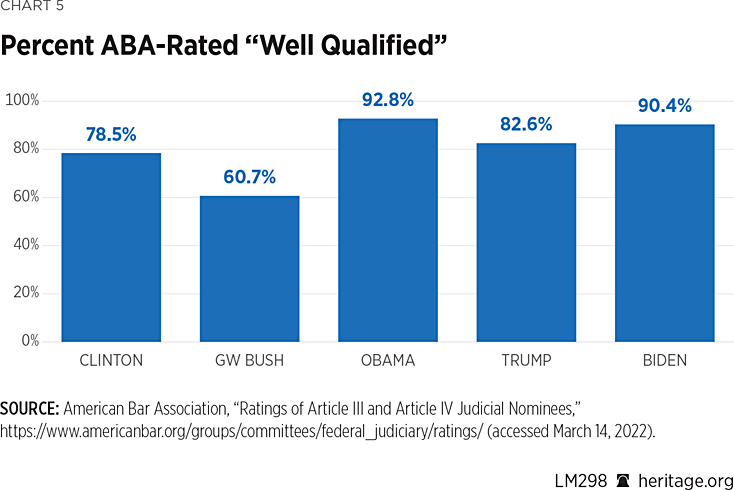
Total Appointments. The most common way to express a President’s judicial appointment success is by the aggregate number of nominees confirmed by the Senate within a specific period of time. This statistic, however, can be misleading both on its own and when used to compare presidential administrations. On its own, the confirmation total will naturally be lower if, for example, few judicial positions are vacant, the President has made few nominations, or few nominees can be confirmed because they have not yet been reported to the full Senate by the Judiciary Committee. For comparative purposes, this statistic does not account for those variables or any changes Congress may have made in the number of Article III judgeships.REF
Charts 6 and 7 minimize these problems. Chart 6 takes vacancies into account, dividing each President’s first-year appointment total by the average vacancy rate during the year. The result is the Confirmation Productivity Index. A lower confirmation total or a consistently higher vacancy rate will limit this measure of confirmation productivity. Chart 7 takes the size of the judiciary into account by presenting each President’s first-year appointment total as a percentage of existing positions on Article III courts filled during that year.
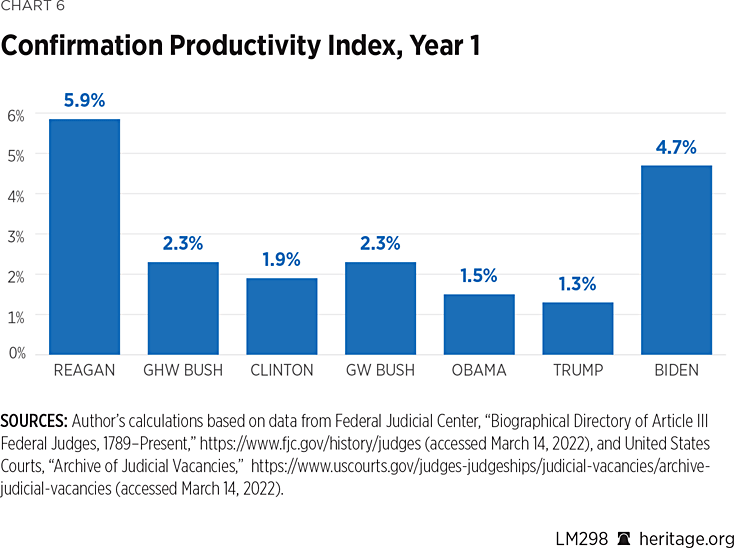
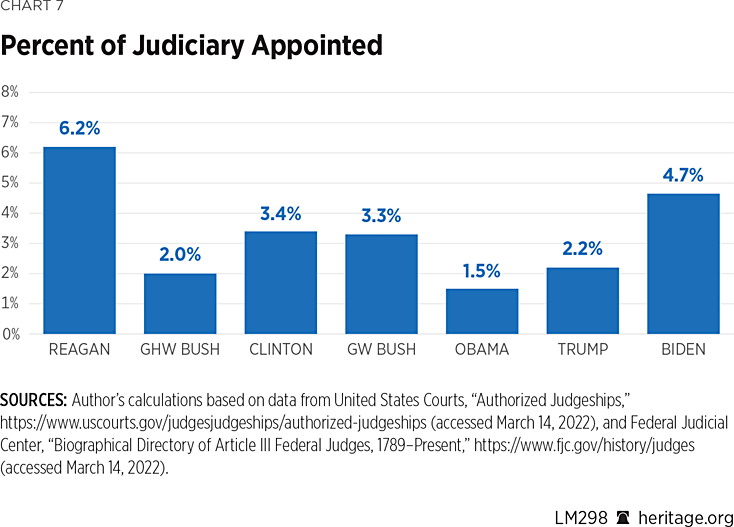
Votes Against Confirmation. As noted above, the historic norm of confirming most judicial nominees without any opposition has changed significantly and, in 2021 at least, may have disappeared entirely. The converse observation that most judicial nominees now have at least some opposition, however, equates opposition by one or two Senators with opposition by nearly half the Senate. One way to go beyond the fact of opposition and assess the level of opposition is to compare the average number of votes against confirmation of each President’s first-year nominees.
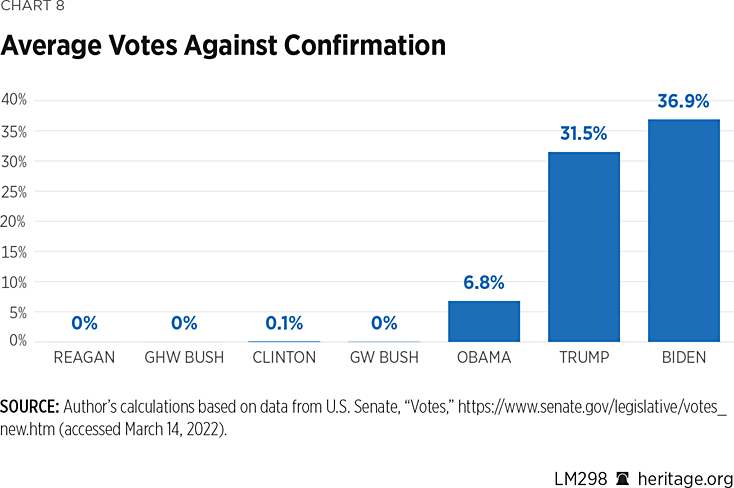
Another way to present opposition to a President’s judicial nominees takes into account that at least some, and sometimes many, Senators are not present for most recorded votes. The number of absent Senators, and whether they are consistent supporters or opponents of a President’s nominees, can inflate or depress the average number of negative votes that nominees receive. One way to account for this is to express opposition as the percentage of votes actually cast on confirmation of a particular nominee.
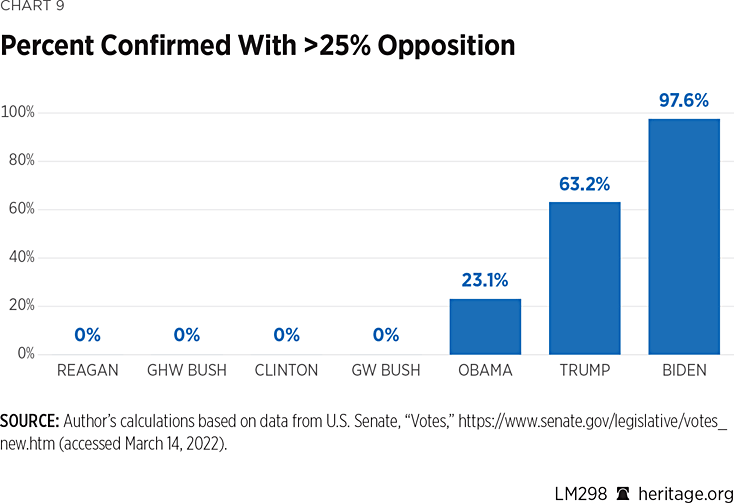
Conclusion
President Biden, with the help of Senate Democrats, is aggressively pursuing his goal of a judiciary that will more reliably deliver liberal political results. His first-year success came despite rapidly changing confirmation process norms including significant overall opposition, use of recorded votes, systematic opposition by other-party Senators, and procedural obstacles such as cloture votes. Biden started making judicial nominations earlier than previous presidents and appointed a larger percentage of the judiciary in his first year than any President in the past four decades.
Thomas Jipping is Senior Legal Fellow in the Edwin Meese III Center for Legal and Judicial Studies, of the Institute for Constitutional Government, at The Heritage Foundation.



